 W
WAn electronic component is any basic discrete device or physical entity in an electronic system used to affect electrons or their associated fields. Electronic components are mostly industrial products, available in a singular form and are not to be confused with electrical elements, which are conceptual abstractions representing idealized electronic components and elements.
 W
WAn adapter or adaptor is a device that converts attributes of one electrical device or system to those of an otherwise incompatible device or system. Some modify power or signal attributes, while others merely adapt the physical form of one connector to another.
 W
WA cam timer or drum sequencer is an electromechanical system for controlling a sequence of events automatically. It resembles a music box with movable pins, controlling electrical switches instead of musical notes.
 W
WA capacitor is a device that stores electrical energy in an electric field. It is a passive electronic component with two terminals.
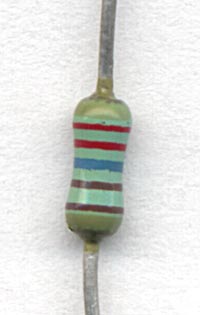 W
WAn electronic color code is used to indicate the values or ratings of electronic components, usually for resistors, but also for capacitors, inductors, diodes and others. A separate code, the 25-pair color code, is used to identify wires in some telecommunications cables. Different codes are used for wire leads on devices such as transformers or in building wiring.
 W
WData visualization achieves its significance today due to information technology: big data processed in computers with capable visualization software, combined with statistical techniques and color coding on electronic displays. This article is about color coding in data visualization.
 W
WA commutator is a rotary electrical switch in certain types of electric motors and electrical generators that periodically reverses the current direction between the rotor and the external circuit. It consists of a cylinder composed of multiple metal contact segments on the rotating armature of the machine. Two or more electrical contacts called "brushes" made of a soft conductive material like carbon press against the commutator, making sliding contact with successive segments of the commutator as it rotates. The windings on the armature are connected to the commutator segments.
 W
WA control knob is a rotary device used to provide manual input adjustments to a mechanical/electrical system when grasped and turned by a human operator, so that differing extent of knob rotation corresponds to different desired input. Control knobs are a simpler type of input hardware and one of the most common components in control systems, and are found on all sorts of devices from taps and gas stoves to optical microscopes, potentiometers and radio tuners.
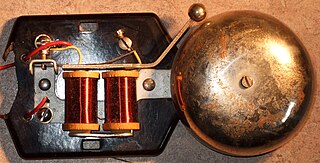 W
WAn electric bell is a mechanical or electronic bell that functions by means of an electromagnet. When an electric current is applied, it produces a repetitive buzzing, clanging or ringing sound. Electromechanical bells have been widely used at railroad crossings, in telephones, fire and burglar alarms, as school bells, doorbells, and alarms in industrial plants, since the late 1800s, but they are now being widely replaced with electronic sounders. An electric bell consists of one or more electromagnets, made of a coil of insulated wire around an iron bar, which attract an iron strip armature with a clapper.
 W
WAn electric switchboard is a device that directs electricity from one or more sources of supply to several smaller regions of usage. It is an assembly of one or more panels, each of which contains switches that allow electricity to be redirected. A switchboard is divided into different interconnected sections, generally consisting of a main section and a distribution section. These two sections are sometimes replaced by a combination section, which is a section that can fulfill the roles of both aforementioned sections. Switchboards can also sometimes come with an auxiliary section that is used to house devices that cannot be housed in the same section as other devices.
 W
WAn electrical contact is an electrical circuit component found in electrical switches, relays, connectors and circuit breakers. Each contact is a piece of electrically conductive material, typically metal. When a pair of contacts touch, they can pass an electrical current with a certain contact resistance, dependent on surface structure, surface chemistry and contact time; when the pair is separated by an insulating gap, then the pair does not pass a current. When the contacts touch, the switch is closed; when the contacts are separated, the switch is open. The gap must be an insulating medium, such as air, vacuum, oil, SF6. Contacts may be operated by humans in push-buttons and switches, by mechanical pressure in sensors or machine cams, and electromechanically in relays. The surfaces where contacts touch are usually composed of metals such as silver or gold alloys that have high electrical conductivity, wear resistance, oxidation resistance and other properties.
 W
WA fault indicator is a device which provides visual or remote indication of a fault on the electric power system. Also called a faulted circuit indicator (FCI), the device is used in electric power distribution networks as a means of automatically detecting and identifying faults to reduce outage time.
 W
WA feedthrough is a conductor used to carry a signal through an enclosure or printed circuit board. Like any conductor, it has a small amount of capacitance. A "feedthrough capacitor" has a guaranteed minimum value of shunt capacitance built in it and is used for bypass purposes in ultra-high-frequency applications. Feedthroughs can be divided into power and instrumentation categories. Power feedthroughs are used to carry either high current or high voltage. Instrumentation feedthroughs are used to carry electrical signals which are normally low current or voltage. Another special type is what is commonly known as RF-feedthrough, specifically designed to carry very high frequency RF or microwave electrical signals.
 W
WAutomotive fuses are a class of fuses used to protect the wiring and electrical equipment for vehicles. They are generally rated for circuits no higher than 32 volts direct current, but some types are rated for 42-volt electrical systems. They are occasionally used in non-automotive electrical products. Automotive fuses are typically housed inside one or more fuse boxes within the vehicle, typically on one side of the engine compartment and/or under the dash near the steering wheel. Some fuses or circuit breakers may nonetheless be placed elsewhere, such as near the cabin fan or air bag controller. They also exist as circuit breakers that are resettable using a switch.
 W
WIn electronics and electrical engineering, a fuse is an electrical safety device that operates to provide overcurrent protection of an electrical circuit. Its essential component is a metal wire or strip that melts when too much current flows through it, thereby stopping or interrupting the current. It is a sacrificial device; once a fuse has operated it is an open circuit, and must be replaced or rewired, depending on its type.
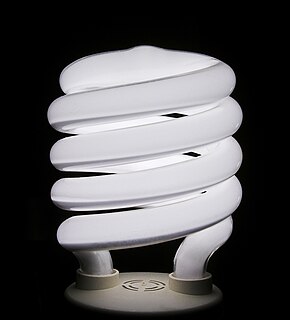 W
WA gas-filled tube, also commonly known as a discharge tube or formerly as a Plücker tube, is an arrangement of electrodes in a gas within an insulating, temperature-resistant envelope. Gas-filled tubes exploit phenomena related to electric discharge in gases, and operate by ionizing the gas with an applied voltage sufficient to cause electrical conduction by the underlying phenomena of the Townsend discharge. A gas-discharge lamp is an electric light using a gas-filled tube; these include fluorescent lamps, metal-halide lamps, sodium-vapor lamps, and neon lights. Specialized gas-filled tubes such as krytrons, thyratrons, and ignitrons are used as switching devices in electric devices.
 W
WAn interrupter in electrical engineering is a device used to interrupt the flow of a steady direct current for the purpose of converting a steady current into a changing one. Frequently, the interrupter is used in conjunction with an inductor to produce increased voltages either by a back emf effect or through transformer action. The largest industrial use of the interrupter was in the induction coil, the first transformer, which was used to produce high voltage pulses in scientific experiments and to power arc lamps, spark gap radio transmitters, and the first X-ray tubes, around the turn of the 20th century. Its largest use was the contact breaker or "points" in the distributor of the ignition system of gasoline engines, which served to periodically interrupt the current to the ignition coil producing high voltage pulses which create sparks in the spark plugs. It is still used in this application.
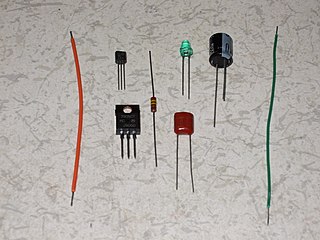 W
WIn electronics, a lead is an electrical connection consisting of a length of wire or a metal pad that is designed to connect two locations electrically. Leads are used for many purposes, including: transfer of power; testing of an electrical circuit to see if it is working, using a test light or a multimeter; transmitting information, as when the leads from an electrocardiograph are attached to a person's body to transmit information about their heart rhythm; and sometimes to act as a heatsink. The tiny leads coming off through-hole electronic components are also often called pins; in ball grid array packages, they are in form of small spheres, and are therefore called "balls".
 W
WAn electric light is a device that produces visible light from electric power. It is the most common form of artificial lighting and is essential to modern society, providing interior lighting for buildings and exterior light for evening and nighttime activities. In technical usage, a replaceable component that produces light from electricity is called a lamp. Lamps are commonly called light bulbs; for example, the incandescent light bulb. Lamps usually have a base made of ceramic, metal, glass, or plastic, which secures the lamp in the socket of a light fixture. The electrical connection to the socket may be made with a screw-thread base, two metal pins, two metal caps or a bayonet cap.
 W
WA memistor is a nanoelectric circuitry element used in parallel computing memory technology. Essentially, a resistor with memory able to perform logic operations and store information, it is a three-terminal implementation of the memristor. It is a possible future technology replacing flash and DRAM.
 W
WA memristor is a non-linear two-terminal electrical component relating electric charge and magnetic flux linkage. It was described and named in 1971 by Leon Chua, completing a theoretical quartet of fundamental electrical components which comprises also the resistor, capacitor and inductor.
 W
WA metal rectifier is an early type of semiconductor rectifier in which the semiconductor is copper oxide or selenium. They were used in power applications to convert alternating current to direct current in devices such as radios and battery chargers. Westinghouse Electric was a major manufacturer of these rectifiers since the late 1920s, under the trade name Westector.
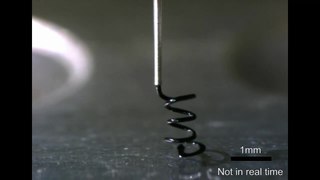 W
WA microcoil is a tiny electrical conductor such as a wire in the shape of a spiral or helix which could be a solenoid or a planar structure. One field where these are found is nuclear magnetic resonance (NMR) spectroscopy, where it identifies radio frequency (RF) coils that are smaller than 1 mm.
 W
WThe non-radiative dielectric (NRD) waveguide has been introduced by Yoneyama in 1981. In Fig. 1 the cross section of NRD guide is shown: it consists of a dielectric rectangular slab of height a and width b, which is placed between two metallic parallel plates of suitable width. The structure is practically the same as the H waveguide, proposed by Tischer in 1953. Due to the dielectric slab, the electromagnetic field is confined in the vicinity of the dielectric region, whereas in the outside region, for suitable frequencies, the electromagnetic field decays exponentially. Therefore, if the metallic plates are sufficiently extended, the field is practically negligible at the end of the plates and therefore the situation does not greatly differ from the ideal case in which the plates are infinitely extended. The polarization of the electric field in the required mode is mainly parallel to the conductive walls. As it is known, if the electric field is parallel to the walls, the conduction losses decrease in the metallic walls at the increasing frequency, whereas, if the field is perpendicular to the walls, losses increase at the increasing frequency. Since the NRD waveguide has been devised for its implementation at millimeter waves, the selected polarization minimizes the ohmic losses in the metallic walls.
 W
WIn electronics, a norator is a theoretical linear, time-invariant one-port which can have an arbitrary current and voltage between its terminals. A norator represents a controlled voltage or current source with infinite gain.
 W
WIn electronics, a nullator is a theoretical linear, time-invariant one-port defined as having zero current and voltage across its terminals. Nullators are strange in the sense that they simultaneously have properties of both a short and an open circuit. They are neither current nor voltage sources, yet both at the same time.
 W
WA nullor is a theoretical two-port network consisting of a nullator at its input and a norator at its output. Nullors represent an ideal amplifier, having infinite current, voltage, transconductance and transimpedance gain. Its transmission parameters are all zero, that is, its input–output behavior is summarized with the matrix equation
 W
WAn opto-isolator is an electronic component that transfers electrical signals between two isolated circuits by using light. Opto-isolators prevent high voltages from affecting the system receiving the signal. Commercially available opto-isolators withstand input-to-output voltages up to 10 kV and voltage transients with speeds up to 25 kV/μs.
 W
WPositronic is a manufacturing company based in Springfield, Missouri. The company manufactures and supplies electronic connectors that are utilized in a variety of industries worldwide including military, aerospace, telecommunications, medical, industrial and test equipment among others.
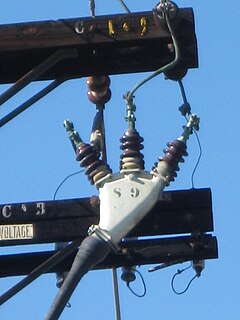 W
WA pothead is a type of insulated electrical terminal used for transitioning between overhead line and underground high-voltage cable or for connecting overhead wiring to equipment like transformers. Its name comes from the process of potting or encapsulation of the conductors inside the terminal's insulating bushing.
 W
WPressure-tolerant electronics (PTE) are electronic components or assemblies that can operate satisfactorily under high pressure, without the need of a high pressure enclosure.
 W
WResistive opto-isolator (RO), also called photoresistive opto-isolator, vactrol, analog opto-isolator or lamp-coupled photocell, is an optoelectronic device consisting of a source and detector of light, which are optically coupled and electrically isolated from each other. The light source is usually a light-emitting diode (LED), a miniature incandescent lamp, or sometimes a neon lamp, whereas the detector is a semiconductor-based photoresistor made of cadmium selenide (CdSe) or cadmium sulfide (CdS). The source and detector are coupled through a transparent glue or through the air.
 W
WA resistor is a passive two-terminal electrical component that implements electrical resistance as a circuit element. In electronic circuits, resistors are used to reduce current flow, adjust signal levels, to divide voltages, bias active elements, and terminate transmission lines, among other uses. High-power resistors that can dissipate many watts of electrical power as heat, may be used as part of motor controls, in power distribution systems, or as test loads for generators. Fixed resistors have resistances that only change slightly with temperature, time or operating voltage. Variable resistors can be used to adjust circuit elements, or as sensing devices for heat, light, humidity, force, or chemical activity.
 W
WA selenium rectifier is a type of metal rectifier, invented in 1933. They were used in power supplies for electronic equipment and in high-current battery-charger applications until they were superseded by silicon diode rectifiers in the late 1960s. The arrival of the alternator in some automobiles was the result of compact, low-cost, high-current silicon rectifiers. These units were small enough to be inside the alternator case, unlike the selenium units that preceded silicon devices.
 W
WA solaristor is a compact two-terminal self-powered phototransistor. The two-in-one transistor plus solar cell achieves the high-low current modulation by a memresistive effect in the flow of photogenerated carriers. The term was coined by Dr Amador Perez-Tomas working in collaboration with other ICN2 researchers in 2018 when they demonstrated the concept in a ferroelectric-oxide/organic bulk heterojunction solar cell.
 W
WA surge arrester is a device to protect electrical equipment from over-voltage transients caused by external (lightning) or internal (switching) events. Also called a surge protection device (SPD) or transient voltage surge suppressor (TVSS), this class of device is used to protect equipment in power transmission and distribution systems. The energy criterion for various insulation material can be compared by impulse ratio. A surge arrester should have a low impulse ratio, so that a surge incident on the surge arrester may be bypassed to the ground instead of passing through the apparatus.
 W
WA terminal is the point at which a conductor from a component, device or network comes to an end. Terminal may also refer to an electrical connector at this endpoint, acting as the reusable interface to a conductor and creating a point where external circuits can be connected. A terminal may simply be the end of a wire or it may be fitted with a connector or fastener.
 W
WA thermopile is an electronic device that converts thermal energy into electrical energy. It is composed of several thermocouples connected usually in series or, less commonly, in parallel. Such a device works on the principle of the thermoelectric effect, i.e., generating a voltage when its dissimilar metals (thermocouples) are exposed to a temperature difference.
 W
WThe trancitor as the combined word of a "transfer-capacitor" is to be considered as another active-device category besides the transistor as a "transfer-resistor". As observed in the table shown, four kinds of active devices are theoretically deduced. Among them, trancitors are missing to be the third and fourth kinds, whereas transistors, such as bipolar junction transistor (BJT) and field-effect transistor (FET), were already invented as the first and second kinds, respectively. Unlike the transistor switching the current at its output, the trancitor transfers its input to the voltage output, so an inverse relationship with each other.
 W
WA transient voltage suppressor or TVS is a general classification of an array of devices that are designed to react to sudden or momentary overvoltage conditions. One such common device used for this purpose is known as the transient voltage suppression diode that is simply a Zener diode designed to protect electronics device against overvoltages. Another design alternative applies a family of products that are known as metal-oxide varistors (MOV) that protect electronic circuits and electrical equipment.
 W
WA transistor is a semiconductor device used to amplify or switch electrical signals and power. The transistor is one of the basic building blocks of modern electronics. It is composed of semiconductor material, usually with at least three terminals for connection to an electronic circuit. A voltage or current applied to one pair of the transistor's terminals controls the current through another pair of terminals. Because the controlled (output) power can be higher than the controlling (input) power, a transistor can amplify a signal. Some transistors are packaged individually, but many more are found embedded in integrated circuits.
 W
WTRUE DC is a type of Switch Disconnect (Isolator) used in Solar Photovoltaic installations, in accordance with EN 60364-7-712. Pioneered by UK based IMO Precision Controls Ltd, and later adopted by other manufacturers such as Santon and ABB, the isolator design incorporates a user independent switching action so as the handle is moved, it interacts with a spring mechanism which, upon reaching a set point, causes the contacts to "SNAP" over, thereby ensuring a very fast break/make action. This mechanism means that the disconnection of the load circuits and the suppression of the electrical arc, produced by a constant DC load, is normally extinguished in a maximum of 5 ms using the specific pole suppression chambers incorporated into the design.
 W
WA vacuum tube, electron tube, valve, or tube, is a device that controls electric current flow in a high vacuum between electrodes to which an electric potential difference has been applied.
 W
WA varistor is an electronic component with an electrical resistance that varies with the applied voltage. Also known as a voltage-dependent resistor (VDR), it has a nonlinear, non-ohmic current–voltage characteristic that is similar to that of a diode. In contrast to a diode however, it has the same characteristic for both directions of traversing current. Traditionally, varistors were indeed constructed by connecting two rectifiers, such as the copper-oxide or germanium-oxide rectifier in antiparallel configuration. At low voltage the varistor has a high electrical resistance which decreases as the voltage is raised. Modern varistors are primarily based on sintered ceramic metal-oxide materials which exhibit directional behavior only on a microscopic scale. This type is commonly known as the metal-oxide varistor (MOV).
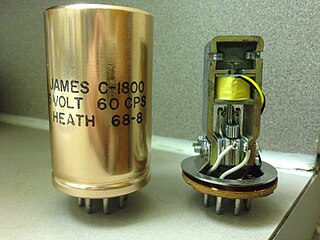 W
WA vibrator is an electromechanical device that takes a DC electrical supply and converts it into pulses that can be fed into a transformer. It is similar in purpose to the solid-state power inverter.
 W
WA voltage portal extends a voltage source to the outside of an electrical enclosure in an encapsulated non-conductive housing designed for a Non-contact voltage detector (NCVD) to sense voltage if placed into the voltage portal.
 W
WA waveguide is a structure that guides waves, such as electromagnetic waves or sound, with minimal loss of energy by restricting the transmission of energy to one direction. Without the physical constraint of a waveguide, wave intensities decrease according to the inverse square law as they expand into three dimensional space.
 W
WA Zetatron is a high-voltage vacuum tube device that generates a stream of neutrons. The stream can be continuous, or rapidly pulsed on and off. It was invented by Sandia National Laboratories, and is manufactured and marketed by the Thermo Electron Corporation. Applications include research, explosives detection, well logging and body fat analysis.